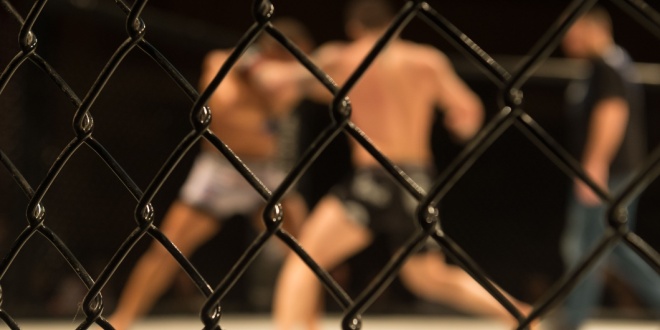Could there be two sporting events more unlike each other than a mixed martial arts caged fight and a tennis match?
Probably not, but in 1998 what would become one of the most successful mixed martial arts organizations in the United States got its start on a tennis tennis court.
“It was at a 12-step recovery ranch in Corona, right next to Interstate 15,” said Terry Trebilcock, Upland resident and founder/chief executive officer of Rancho Cucamonga-based King of the Cage, an MMA league. “I used some recovering alcoholics to help clean everything up, they put a tarp on the tennis court, and we had the event there. We ended up drawing about 800 people.”
Trebilicock, 56, started King of the Cage after he realized that, no matter how hard he trained, he was never going to be an MMA fighter, much less one of the sport’s elite competitors. It was similar to the feeling he got when he was on the golf team at Cal State Fullerton, dreaming of a career on the PGA Tour.
“I really thought I was going to play professional golf for a living,” said Trebilcock, an Upland resident. “But I never became more than a decent player, and I decided that college wasn’t for me anyway.
“But if I had been a better player, I would still be playing golf.”
Trebilicock began managing athletic clubs, and trained next to body builders, fighters and college wrestlers. He was familiar with the MMA and aspired to a career there.
By that time Trebilcock had developed an understanding of MMA and what made a competitive MMA fighter. He also saw a business opportunity. He believed MMA needed a few tweaks, starting with an accepted set of rules, to broaden its appeal.
“So I became a promoter,” Trebilcock said. “I realized that the sport’s weakness was in the promotion, not the athlete. They were world-class Olympic at athletes, so there was no problem there.”
Today, King of the Cage bills itself as the “most prolific” MMA promotion in the world, having held more than 900 events during the past 15 years throughout North America, Europe, Asia, South Africa and Australia.
In 2009, King of the Cage partnered with Lucas Oil, owner of MAVTV, where King of the Cage matches can be found. It’s one of only a few MMA circuits on international television, and it can also be seen via pay-per-view on Pluto TV and Spectrum On Demand.
Trebilicock spoke recently with IE Business Daily about the origins of King of the Cage, the appeal of mixed martial arts, and where he believes the sport is headed in the next 10 years.
IEBD: What’s the best way to describe mixed martial arts to someone who is not familiar with it?
Trebilcock: it’s a mix of four Olympic sports. Kick boxing, tae kwan do, jiui jitsu and wrestling. Wrestling includes free-style and Greco Roman. It’s very much a hybrid sport.
IEBD: What are the rules?
Trebilcock: They’re essentially the same as UFC (Ultimate Fighting Championship). Five-minute rounds, which we invented. No punches to the back of the head, the groin or the spine. No head butting, eye gouging, or hair pulling, and you can’t intentionally throw your opponent out of the ring. There are other rules, but those are the main ones.
IEBD: How did you get into mixed martial arts?
Trebilcock: Around 1994 and 1995, I started watching MMA on television. I thought it might be something for me, so I trained for about a year and a half. I was training against the best guys in the world, and I realized it wasn’t for me. I was better off putting two people in the ring than trying to do it myself.
IEBD: You didn’t think you could compete?
Trebilcock: I knew I could not compete, athletically, against those people. In those days, if you weren’t in the top five, you weren’t making money. And I am talking about Olympic wrestlers, some of the best athletes in the world. It’s a whole different level of athleticism that I was dealing with.
IEBD: How did you start your career as a promoter? How were you able to connect with MMA fighters?
Trebilcock: I opened some martial arts studios in the health clubs I was managing. I had about 50 mixed martial arts people training in the facilities I was managing, and I got to know a lot of them.
IEBD: Why did you believe MMA’s promotion was weak?
Trebilcock: It wasn’t being done by business people. I thought I could bring the kind of marketing I used with my health clubs to MMA.
IEBD: MMA also had some other problems at the time.
Trebilcock: Yes, it did. There were a lot of renegade groups doing shows all over the state. I loved watching them, but I figured there had to be a way to make it legitimate and legal, so I started campaigning before the California State Athletic Commission. After about a year I got their approval, and we did our first show in 1999.
IEBD: How did you promote your first event, the one on the tennis court?
Trebilcock: It was pretty simple. I went to about 30 of my friends and asked them to commit to selling $1,000 worth of tickets, and I gave each of them 40 tickets, at $25 a ticket. A couple of them fell short, a couple of them asked for more tickets, but in the end we got 800 people to watch. It was an off-the-wall approach, but it worked. Three guys who eventually fought for the UFC title were on the card that night.
IEBD: Not a bad start.
Trebilcock: No, and the people who were there that night ended up being the ringside season-ticket holders at Soboba Casino for the next five to seven years. But the athletic commission declined my request to put on a second show.
IEBD: Why?
Trebilcock: At the time, there were six or seven MMA circuits in California, but they weren’t providing ringside doctors, they didn’t have ambulances at their fights, they weren’t providing proper medical insurance. There was also some question about whether MMA was legal and what the rules were. So I went to the commission and showed them my medical insurance and explained how I would comply with their medical regulations.
IEBD: And you got your permit?
Trebilcock: No. They suggested that I go to an Indian reservation, where the state has no authority because it’s a sovereign nation. Which is what I ended up doing. I went to 63 casinos across the country, and Soboba was the only one interested.
IEBD: Where did it go from there?
Trebilcock: Well, it worked. Soboba eventually built us a 5,000-seat outdoor facility, and we sold it out night after night. At that point, the casinos that turned us down the first time started to get interested, because the people we got to watch King of the Cage went into the casino and gambled. From their perspective, gambling was the important thing.
IEBD: Today you do a lot of your events in casinos.
Trebilcock: About 70 percent of them. On any given day we might hold events at 15 casinos all over the country. The prize money for a win can be up to $100,000.
IEBD: Why did you decide to put on cage matches?
Trebilcock: I saw UFC matches in cages and thought we could do something similar to that. The cage gives an appeal that I think makes it more edgy, and it makes the fight safer. No one gets thrown out of the cage like they would in a ring. MMA includes wrestling, so getting thrown out of the ring would be a real possibility.
IEBD: Can you talk about your relationship with UFC?
Trebilcock: We’ve competed with the UFC for years, and they’re always trying to make us seem amateurish, but that’s false. About 75 percent of the 11,000 fights I’ve promoted have been professionals. I always include a couple of local amateurs on the undercard, because you want to stir up some interest in the local community. But you do that for a Mike Tyson fight or an Oscar de la Hoya fight. You don’t see them on television, but they’re on the card. But the UFC took that and tried to make something of it.
IEBD: What’s the difference between UFC and King of the Cage?
Trebilcock: They’re just two different leagues, but UFC is bigger. They’re like the New York Yankees, and King of the Cage is the Florida Marlins. But the Yankees don’t win the World Series every year, do they?
IEBD: Do you think MMA will ever replace boxing?
Trebilcock: I don’t think so. I think boxing will always have its place. But it’s definitely back on its heels in the United States, mostly because of MMA, I think. MMA has a lot of appeal to young people.
IEBD: What is the future of MMA? Has it peaked, or has it yet to hit its ceiling?
Trebilcock: I think it will plateau over the next 10 years. Right now, there’s too much of it on television, and some of the lower-end leagues will go away. That will make the sport stronger. We’ll see what happens.
 IE Business Daily Business news for the Inland Empire.
IE Business Daily Business news for the Inland Empire.


